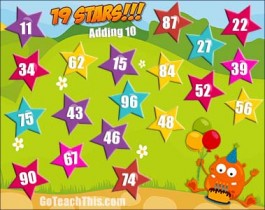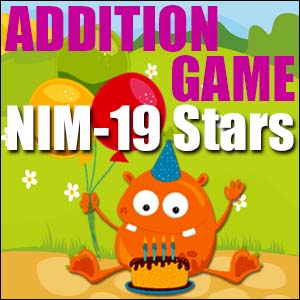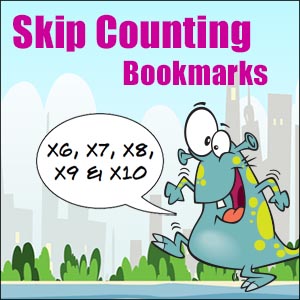Addition Game
NIM – 19 Stars

Game in a Nutshell:
Students begin the game with each of the 19 stars on the playing board covered by counters. The players take turns to remove one or two counters and say aloud an algorithm that gives the number revealed as the answer. NB The algorithm given must be from the number fact family written on the board e.g. “Adding 9” ,“Doubles +1” etc. This allows students to explore a wide variety of techniques and number relationships within one game. It also enables practice in deconstructing and reconstructing numbers which is a crucial aspect of becoming numerate.
What You Need:
2 players
1 Nineteen Stars game board
19 opaque counters
Preparation for Play:
– Students cover all the stars with counters
A Little Something You Need to Know:
There are two options to choose from when removing counters:
1. Removing ONE counter
If a student was playing the Adding 9 board and removed a counter revealing 93, they would have to give the algorithm 84+9=93, because one of the addends must be nine. If they were playing the Doubles board and they revealed 16, they would have to give two addends that are the same, 8+8=16.
or
2. Removing TWO counters
If a student was playing the Doubles + 1 board and removed two counters revealing 15 :& 11 they would give EITHER the 7+8=15 or 5+6=11

How to Play:
1. Students measure the distance from the base of their palms to the tip of their index finger. The student with the shortest measurement becomes Player One.
3. Player One removes any SINGLE counter from the board and says the algorithm aloud required to give the number uncovered.
4. Player Two then removes either one OR two counters then gives the algorithm to ONE of the numbers uncovered.
5. Player One then chooses to either pick up one or two counters.
6. The game continues in this turnabout fashion until there is only one counter left.
How to Win:
The player who leaves only one counter for their opponent to pick up is declared the winner.
An Agreed Rule:
– As a class create a rule for what happens in the event of an incorrect algorithm being given. NB The rule needs to help the students recognize the need to promote the use of efficient strategies, accurate answers & mathematical thinking. The rule is not to be a ‘punishment’.
Variations:
– Students begin with an empty board and place the counters onto the stars. The student who covers the last star is the winner.
– The student who places the last counter loses the game.
– Students use the blank board to create their own version of the game.
Before the Game:
- Use the PowerPoint file to conduct Number Talks on possible mathematical strategies to use to make the game flow and ensure mathematical learning is taking place.
- THINK, PAIR, SHARE – Describe to a partner how you would find the algorithm required for… SHARE the answer with the class.
- With their partner, students orally answer, ‘What are we supposed to learn when we play this game?’ Students record their responses.
- Have students orally restate the game rules orally to their partner before they go off to play.
- Written Response – What do you do when you try to learn a new number fact?
During the Game:
– Remind students to be sure they and their partner are working on efficient number strategies.
– Encourage the students to look for patterns and devise a strategy for winning as they remove counters from the board.
– Encourage the students to monitor and predict the thinking of their opponents.
After Game Reflection Questions:
– What have you learned as a result of playing this game?
– What patterns did you notice when you were playing this game?
– What pointers can you give other students to help them do well at this game?
– Does it make any difference if you go first or second in this game? Explain your answer.
– What do you feel is the most important part of playing this game?
Possible Cross-Curricular Extension Activity:
In pairs students create the back story to the game story using the following questions to get the creative juices flowing:
– Where and when in the universe is the game taking place?
– Who is involved in this story?
– Why are some of the characters on the board wearing party hats?
– What has happened to make the 19 stars grouped so closely together and so near to the ground?
– Why are there numbers on the stars?
– Why are two giant beings picking up counters in this cartoon world?
– Ask your own questions about the game board and answer them.
– Now tell your story out loud to a partner.
Included in this Download:
EXPLORE MORE




